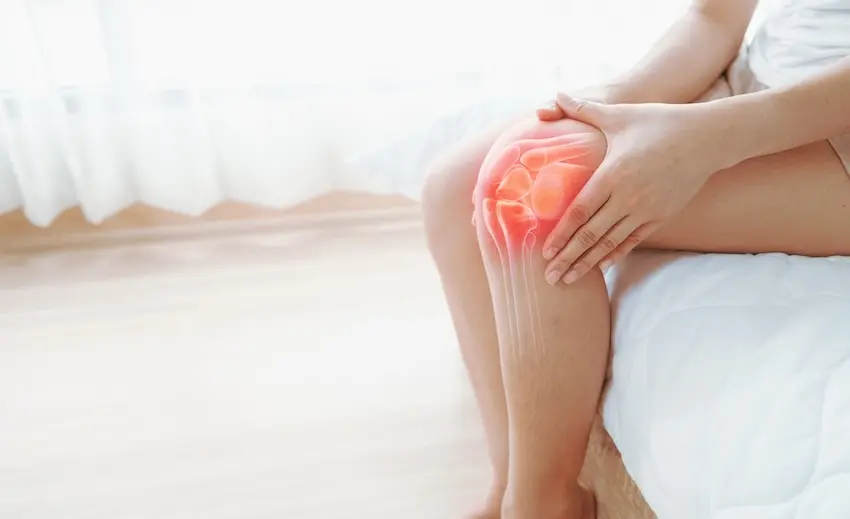Advanced Pain Relief and Joint Care for Lasting Mobility
Arthritis is inflammation and degeneration of one or more joints, causing pain, stiffness, swelling, and reduced range of motion that progressively limits daily activities and quality of life. While often dismissed as an inevitable part of aging, arthritis is a treatable medical condition with multiple forms—each requiring specific diagnostic evaluation and targeted intervention.At VeriSpine Joint Centers, our metro Atlanta specialists have spent over 30 years helping patients manage arthritis pain and preserve joint function. We understand that living with arthritic joint pain isn’t just about discomfort—it’s about maintaining your independence, staying active with family, and continuing the work and hobbies you value. Our comprehensive approach combines advanced pain management, regenerative medicine, and personalized rehabilitation to help you reclaim mobility and reduce daily limitations.
Arthritis Affects Over 50 Million Americans: You’re not alone in this struggle. One in four adults lives with doctor-diagnosed arthritis, making it the leading cause of disability in the United States. The good news? Modern treatment options can significantly reduce pain, slow disease progression, and restore function—even for patients who’ve lived with arthritis for years.

Understanding Arthritis: Expert Physician Insights Beyond ‘Wear and Tear
The term “arthritis” encompasses over 100 different conditions affecting joints, surrounding tissues, and connective structures. While the symptoms—pain, stiffness, swelling—may appear similar, the underlying mechanisms vary significantly. Accurate diagnosis determines which treatments will provide the most effective relief.
Joint arthritis develops when the protective cartilage cushioning bone ends deteriorates, allowing bones to rub together. This creates inflammation, pain, and progressive damage. In some arthritis types, the immune system mistakenly attacks healthy joint tissue. Others result from metabolic abnormalities, infections, or traumatic injury. Each arthritis variant follows distinct patterns and responds to different therapeutic interventions.
“I thought arthritis meant I’d just have to accept pain as part of getting older. My VeriSpine doctor showed me that proper treatment could give me back the activities I’d already given up on.” — VeriSpine Patient, Age 58
How Untreated Arthritis Progresses: What Our Doctors See
Arthritis isn’t static—it worsens over time without appropriate intervention. Early stages might involve occasional joint discomfort after activity. As cartilage breakdown advances, pain becomes more frequent and intense. Joint inflammation increases, causing visible swelling and warmth. Bone spurs develop at joint margins, further restricting movement. Eventually, severe arthritis can cause joint deformity, chronic pain at rest, and significant disability.
This progression isn’t inevitable. Early diagnosis and treatment can slow or halt cartilage destruction, reduce inflammatory damage, maintain joint alignment, and preserve function for decades. The key is addressing arthritis before irreversible changes occur—which is why prompt evaluation matters when joint symptoms develop.
Types of Arthritis Our Atlanta Doctors and Physicians Treat
Through decades of experience treating over 50,000 metro Atlanta patients, our physicians have developed expertise across the full spectrum of arthritic conditions. Understanding your specific arthritis type guides our treatment approach:
Degenerative Arthritis Conditions Our Physicians Treat
Osteoarthritis
The most common arthritis form, affecting 32.5 million U.S. adults. Cartilage gradually breaks down from mechanical wear, age-related changes, or previous injury. Primarily affects knees, hips, hands, and spine. We provide joint injections, viscosupplementation, regenerative therapies, and comprehensive pain management.
Spinal Arthritis (Spondylosis)
Degenerative changes in facet joints, vertebral bodies, and intervertebral discs causing neck or back pain and stiffness. Creates nerve compression when bone spurs narrow spinal openings. Our interventional spine procedures target pain sources directly.
Post-Traumatic Arthritis
Develops months or years after joint injury—from auto accidents, sports trauma, or workplace incidents. Previous fractures, ligament tears, or cartilage damage accelerate arthritis development. We specialize in injury-related arthritis management with insurance coordination expertise.
Inflammatory Arthritis Treatment by VeriSpine Specialists
Rheumatoid Arthritis
Autoimmune condition where the immune system attacks joint linings, causing inflammation, pain, and progressive damage. Typically affects multiple joints symmetrically. Requires coordination with rheumatologists while we manage pain and maintain function through targeted interventions.
Psoriatic Arthritis
Joint inflammation occurring in some people with psoriasis skin condition. Causes joint pain, stiffness, and swelling, often affecting fingers, toes, and spine. Our multidisciplinary approach addresses both joint symptoms and functional limitations.
Ankylosing Spondylitis
Inflammatory arthritis primarily affecting the spine and sacroiliac joints, causing progressive stiffness and potential spinal fusion. Morning stiffness lasting hours is characteristic. We provide targeted SI joint injections and spinal interventions.
Metabolic Arthritis
Gout
Uric acid crystals accumulate in joints, causing sudden, severe pain attacks—typically affecting the big toe but can impact any joint. We manage acute gout flares and provide ongoing arthritis treatment when chronic joint damage develops.
Pseudogout (CPPD)
Calcium pyrophosphate crystals deposit in joints, creating gout-like attacks. Commonly affects knees, wrists, and shoulders. Treatment includes joint aspiration, corticosteroid injections, and inflammation management.
Joint Arthritis Locations Our Atlanta Doctors Specialize In
Knee Arthritis Treatment by VeriSpine Doctors
Most frequently treated joint. Causes pain with walking, stairs, standing, and kneeling. We offer viscosupplementation, steroid injections, and stem cell therapy.
Hip Arthritis Relief and Joint Pain Management
Creates groin or buttock pain, limping, and difficulty with shoes/socks. Intra-articular injections and regenerative treatments delay surgical needs.
Shoulder Arthritis Physician-Directed Treatment
Limits overhead activities, dressing, and reaching. Treated with targeted shoulder injections and physical therapy protocols.
Hand and Finger Arthritis Specialist Care
Affects grip strength, fine motor skills, and daily tasks. Management includes joint protection strategies and targeted therapies.
Spine Arthritis and Back Pain Treatment
Cervical, thoracic, or lumbar involvement causing back/neck pain and stiffness. Facet injections and medial branch blocks provide direct relief.
SI Joint Arthritis Doctor-Administered Injections
Sacroiliac joint degeneration creating lower back and hip pain. Specialized SI joint injections are highly effective.

Recognizing Arthritis Symptoms: When to See a Doctor
Arthritis symptoms vary by type and severity, but certain patterns warrant medical evaluation. Early recognition enables intervention before significant joint damage occurs:
Arthritis Symptoms: When to See a Doctor
- Joint Pain: Ranging from dull aching to sharp, severe discomfort. May be constant or intermittent. Often worsens with activity (osteoarthritis) or improves with movement (inflammatory arthritis).
- Stiffness: Particularly after rest or upon waking. Morning stiffness duration helps differentiate arthritis types—under 30 minutes suggests osteoarthritis, over an hour indicates inflammatory conditions.
- Swelling: Visible joint enlargement from inflammation and fluid accumulation. Joint may feel warm to touch, especially in inflammatory arthritis.
- Reduced Range of Motion: Difficulty fully bending, straightening, or rotating affected joints. Movement becomes progressively restricted as arthritis advances.
- Grinding or Clicking: Crepitus—the sensation or sound of bones rubbing together when moving joints with deteriorated cartilage.
- Joint Weakness: Muscles around arthritic joints weaken from disuse and pain avoidance, creating instability and increasing fall risk.
- Deformity: In advanced cases, visible joint changes including bone spurs, joint enlargement, or finger nodules.
Urgent Arthritis Symptoms Requiring Immediate Physician Evaluation
- Sudden, severe joint pain with significant swelling
- Joint redness and warmth suggesting possible infection
- Inability to use or bear weight on the affected joint
- Fever accompanying joint symptoms
- Rapid progression of symptoms over days or weeks
- Multiple joints becoming simultaneously painful and swollen
How Arthritis and Joint Pain Impact Your Daily Life
Beyond physical discomfort, arthritis creates cascading effects across every life domain. Understanding these impacts helps us develop treatment plans addressing your specific challenges:
How Joint Arthritis Affects Mobility and Independence
Knee or hip arthritis makes walking, climbing stairs, and standing progressively difficult. Simple errands become exhausting expeditions. You might avoid certain activities entirely, leading to social isolation and reduced fitness. Hand arthritis interferes with opening jars, buttoning clothes, or using utensils—forcing dependence on others for previously simple tasks. This loss of independence affects self-esteem and mental health as much as physical wellbeing.
Arthritis Impact on Work: When to Consult an Atlanta Physician
Arthritis is the most common cause of work disability in the United States. Physical jobs become impossible when joint pain prevents lifting, standing, or repetitive movements. Even desk work suffers—typing hurts arthritic fingers, sitting aggravates spine arthritis, and chronic pain reduces concentration. Absenteeism increases. Productivity declines. Some patients face difficult decisions about career changes or early retirement when arthritis progresses despite treatment.
Sleep Quality
Arthritic joint pain disrupts sleep through position-dependent discomfort. You shift frequently seeking comfort, fragmenting sleep architecture. Morning stiffness is worse after poor sleep. This creates a vicious cycle: pain prevents sleep, sleep deprivation increases pain perception, worsening symptoms intensify sleep disruption. Chronic sleep deficiency compounds fatigue, reduces pain tolerance, and affects cognitive function.
Exercise and Physical Health
Joint pain discourages physical activity, yet inactivity accelerates arthritis progression. Muscles weaken without use, reducing joint stability. Weight gain from reduced activity increases joint stress. Cardiovascular fitness declines. Bone density decreases. The deconditioning spiral worsens both arthritis symptoms and overall health—creating additional medical problems like diabetes, heart disease, and depression.
Emotional and Psychological Wellbeing
Chronic arthritis pain creates significant psychological burden. Depression affects up to 40% of arthritis patients—higher than the general population. Anxiety about disease progression, future disability, or loss of independence is common. Frustration with physical limitations, loss of valued activities, and chronic discomfort erodes quality of life. The mind-body connection means psychological distress intensifies pain perception, while effective pain management often improves mood.
Financial Impact
Direct medical costs for arthritis treatment, medications, and procedures accumulate. Indirect costs from reduced work capacity, lost wages, or early retirement can exceed direct expenses. Home modifications, assistive devices, and increased care needs add financial strain. Understanding insurance coverage—especially for auto accident or work-related arthritis—is crucial for accessing necessary treatment.
Comprehensive Arthritis Diagnosis by VeriSpine Physicians
Effective arthritis treatment begins with accurate diagnosis. Many arthritis types share similar symptoms but require different interventions. At VeriSpine, our diagnostic evaluation identifies your specific condition and guides personalized treatment:
Detailed Medical HistorySymptom onset, pattern, duration, aggravating/relieving factors, previous injuries, family history of arthritis, and impact on daily function provide diagnostic clues.
Physical ExaminationJoint inspection for swelling, warmth, redness, deformity. Palpation for tenderness and crepitus. Range of motion assessment. Gait analysis. Muscle strength testing.
Diagnostic ImagingX-rays reveal joint space narrowing, bone spurs, alignment changes, and fractures. MRI shows cartilage damage, soft tissue inflammation, and early changes invisible on X-ray.
Laboratory TestingBlood tests for inflammatory markers (ESR, CRP), rheumatoid factor, anti-CCP antibodies, uric acid levels. Helps differentiate inflammatory from degenerative arthritis.
Joint Aspiration (When Indicated)Removing and analyzing joint fluid rules out infection, identifies crystal arthritis (gout/pseudogout), and assesses inflammatory cell counts.
Functional AssessmentStandardized questionnaires (WOMAC, HAQ-DI) quantify pain severity, stiffness levels, and functional limitations for treatment planning and progress monitoring.
This comprehensive approach distinguishes between arthritis types, identifies contributing factors (obesity, biomechanical issues, inflammatory conditions), determines disease severity, and establishes baseline measurements for tracking treatment response. Accurate diagnosis is the foundation of effective arthritis management.

Advanced Arthritis Treatment Options at VeriSpine Joint Centers
Our multidisciplinary arthritis treatment combines evidence-based interventions tailored to your specific diagnosis, symptom severity, and functional goals. We emphasize non-surgical approaches that provide lasting relief while preserving joint function:
Arthritis Joint Injections: Physician-Administered Pain Relief
Corticosteroid Injections: Powerful anti-inflammatory medication delivered directly into arthritic joints provides rapid pain relief and reduces swelling. Effective for osteoarthritis, inflammatory arthritis flares, and arthritis-related bursitis. Relief typically lasts 6 weeks to 6 months depending on arthritis severity.
Viscosupplementation (Hyaluronic Acid): Injecting lubricating fluid into arthritic knees improves joint cushioning and reduces pain. Particularly effective for mild-to-moderate knee osteoarthritis. Provides longer-lasting relief than steroid injections for many patients.
Nerve Blocks: For spinal arthritis, facet joint injections and medial branch blocks interrupt pain signals from arthritic spinal joints. Genicular nerve blocks target knee arthritis pain pathways.
Regenerative Medicine for Arthritis: Advanced Physician-Led Therapy
Our innovative stem cell treatments and platelet-rich plasma (PRP) therapy harness your body’s healing potential. These regenerative approaches may stimulate cartilage repair, reduce inflammation, improve joint lubrication, and slow arthritis progression. Best suited for patients seeking alternatives to surgery or those with early-to-moderate arthritis. We employ current best practices while protecting patients from unproven therapies through careful patient selection and evidence-based protocols.
Physical Therapy and Rehabilitation
Specialized arthritis rehabilitation addresses multiple treatment goals simultaneously. Strengthening exercises stabilize arthritic joints and reduce pain. Range of motion work maintains flexibility and prevents contractures. Low-impact aerobic conditioning improves overall fitness without stressing joints. Manual therapy techniques reduce muscle tension and improve joint mechanics. Our therapists also teach joint protection strategies, proper body mechanics, and activity modification that allow you to stay active while minimizing arthritis aggravation.
Medication Management
Pharmaceutical therapy forms part of comprehensive arthritis care. Over-the-counter NSAIDs (ibuprofen, naproxen) reduce pain and inflammation for mild arthritis. Prescription medications may include COX-2 inhibitors for patients at risk of GI complications, topical analgesics for localized arthritis, or neuropathic pain medications when nerve involvement exists. For inflammatory arthritis, we coordinate with rheumatologists managing disease-modifying drugs while we address pain and function.
Weight Management and Lifestyle Optimization
Excess body weight dramatically accelerates arthritis progression—every pound adds 4 pounds of pressure on knees. Even modest weight loss (5-10% of body weight) significantly reduces arthritis pain and improves function. We provide guidance on sustainable dietary changes, refer to nutrition specialists when appropriate, and develop exercise programs that promote weight loss without overloading damaged joints. Anti-inflammatory nutrition patterns may also reduce systemic inflammation contributing to arthritis symptoms.
Assistive Devices and Orthotics
Strategic use of supportive equipment reduces joint stress and maintains independence. Knee braces unload arthritic compartments. Shoe inserts correct biomechanical issues contributing to arthritis. Canes or walkers reduce weight-bearing stress. Adaptive tools help arthritic hands perform daily tasks. We evaluate which devices benefit your specific situation and provide proper fitting and training.
Most patients achieve optimal outcomes through combinations of these therapies rather than single interventions. We continuously assess your response and adjust treatment protocols to maximize pain relief, preserve function, and maintain quality of life.
Frequently Asked Questions About Arthritis Treatment and Care
Can arthritis be cured or will I always have it?
Most arthritis types cannot be cured, but symptoms can be effectively managed, progression can be slowed, and function can be maintained or improved through appropriate treatment—meaning you can live well with arthritis rather than simply enduring it.
Osteoarthritis involves permanent cartilage loss that current medicine cannot fully regenerate, though regenerative therapies may stimulate partial repair. Inflammatory arthritis like rheumatoid arthritis can enter remission with proper medication, though the autoimmune tendency remains. However, “incurable” doesn’t mean “untreatable.” Modern interventions dramatically reduce pain, maintain joint function, prevent deformity, and allow most patients to remain active and independent. Many VeriSpine patients with arthritis report 60-80% pain reduction and return to activities they’d abandoned. The key is comprehensive, ongoing management rather than seeking a one-time cure. Early intervention produces better long-term outcomes by preventing irreversible joint damage.
How long do arthritis joint injections provide relief?
Corticosteroid arthritis injections typically provide 6 weeks to 6 months of relief, while viscosupplementation may last 6-12 months, depending on arthritis severity, injection accuracy, and individual response—many patients achieve sustained benefit through periodic injections combined with other therapies.
Relief duration varies by several factors. Mild arthritis generally responds longer than severe degeneration. Accurately placed injections under fluoroscopic or ultrasound guidance outperform blind injections. Some patients experience dramatic, long-lasting improvement from a single injection, while others need repeat treatments every 3-4 months. The injection itself provides temporary benefit, but reduced inflammation allows physical therapy and exercise to become more effective, creating lasting functional gains. Most insurance plans cover 3-4 joint injections annually. At VeriSpine, we use injections strategically within comprehensive treatment plans rather than as standalone therapy. When injection benefits become progressively shorter-lived despite optimization, this may indicate arthritis severity requiring different interventions or consideration of surgical options.
Is exercise good or bad for arthritis—will it cause more damage?
Appropriate exercise is one of the most effective arthritis treatments, reducing pain, improving function, and slowing progression without causing joint damage when performed correctly—inactivity actually worsens arthritis through muscle weakening, weight gain, and joint stiffness.
The “motion is lotion” principle applies to arthritic joints. Movement pumps nutrients into cartilage, maintains range of motion, strengthens supporting muscles, and reduces pain perception. Research consistently shows exercise reduces arthritis pain by 25-40% and improves function significantly. The key is choosing appropriate activities: low-impact options like swimming, cycling, water aerobics, walking, and tai chi provide benefits without excessive joint stress. Strengthening exercises should target muscles supporting arthritic joints. Avoid high-impact activities like running on hard surfaces, jumping, or sports involving sudden direction changes. Listen to your body—mild discomfort during exercise is acceptable, but sharp pain or prolonged post-exercise flare-ups indicate excessive intensity. Our physical therapists design arthritis-appropriate exercise programs that maximize benefits while protecting damaged joints. Starting gradually and building tolerance prevents overuse injuries while delivering proven arthritis benefits.
Does cold weather really make arthritis worse?
Many arthritis patients report increased pain and stiffness with cold, humid weather and barometric pressure changes, though scientific evidence for direct weather effects remains mixed—the relationship appears real for some individuals, but mechanisms aren’t fully understood.
Several theories explain weather sensitivity. Barometric pressure drops before storms may cause joint tissues to expand, increasing pain. Cold temperatures may increase joint fluid viscosity, creating stiffness. Weather changes might affect pain threshold through neurological mechanisms. Alternatively, cold weather reduces activity levels and increases sedentary time, which worsens arthritis symptoms. Seasonal depression common in winter may lower pain tolerance. Whatever the mechanism, many patients consistently experience weather-related symptom fluctuations. Practical management includes keeping joints warm with layered clothing, maintaining indoor activity during cold months, using heating pads for stiff joints, and recognizing that weather-induced flares are temporary. Some patients find relocating to warmer climates helps, though this isn’t practical or necessary for most. Our treatment plans help you manage arthritis regardless of weather, reducing symptom variability throughout the year.
Will arthritis require joint replacement surgery eventually?
Only about 10-15% of osteoarthritis patients ultimately need joint replacement, and many can avoid or significantly delay surgery through comprehensive conservative management—surgery becomes necessary only when arthritis severely limits function despite optimal non-surgical treatment.
Joint replacement is elective surgery for end-stage arthritis causing intolerable pain or severe disability unresponsive to other interventions. Indications include constant pain interfering with sleep, inability to perform basic daily activities, progressive deformity, or quality of life severely compromised despite maximum medical management. However, many patients maintain acceptable function for decades without surgery using our multidisciplinary approach: injections control pain and inflammation, physical therapy maintains strength and mobility, weight management reduces joint stress, assistive devices compensate for limitations, and regenerative medicine may slow progression. When surgery becomes appropriate, having maintained muscle strength and cardiovascular fitness through conservative care improves surgical outcomes and recovery. We help you make informed decisions about surgical timing based on your functional needs, symptom severity, and treatment response—neither rushing to surgery prematurely nor delaying when it would restore quality of life.
Are there specific foods that help or worsen arthritis symptoms?
Anti-inflammatory dietary patterns—emphasizing omega-3 fatty acids, colorful fruits and vegetables, whole grains, and limiting processed foods and added sugars—may reduce arthritis inflammation and pain for many patients, though food effects vary individually and diet alone cannot cure arthritis.
Beneficial foods include fatty fish (salmon, sardines, mackerel) rich in omega-3s that reduce inflammatory compounds; berries, cherries, and dark leafy greens containing antioxidants that combat oxidative stress; nuts, olive oil, and avocados providing healthy fats; and spices like turmeric and ginger with anti-inflammatory properties. Mediterranean and DASH diets consistently show arthritis benefits in research. Conversely, highly processed foods, excess sugar, refined carbohydrates, and excessive red meat may increase inflammation. Some individuals have personal trigger foods—common culprits include nightshade vegetables (tomatoes, peppers, eggplant) and dairy, though scientific evidence for universal triggers is limited. Weight loss from any healthy diet reduces arthritis pain simply by decreasing joint stress. We recommend focusing on overall dietary patterns rather than individual “superfoods.” Keep a food diary if you suspect specific triggers. Dietary changes complement but don’t replace medical treatment. Significant symptom improvement may take 4-8 weeks of consistent dietary modification.
Does arthritis from an auto accident qualify for different insurance coverage?
Yes, post-traumatic arthritis developing after auto accidents typically falls under personal injury protection (PIP) or liability claims rather than health insurance, potentially covering all medically necessary treatment without copays or deductibles, though documentation requirements differ from standard arthritis care.
Auto insurance coverage for accident-related arthritis includes initial treatment for acute injuries plus ongoing care for resulting arthritis—even if arthritis develops months or years post-accident. You’ll need medical documentation establishing causal connection between collision and arthritis development, typically through records showing injury severity, imaging demonstrating joint damage, and physician narrative linking trauma to arthritic changes. PIP benefits in no-fault states provide immediate coverage up to policy limits. At-fault claims access the responsible party’s liability insurance, often with higher limits. Treatment authorization processes differ from health insurance—some insurers require pre-approval for procedures, regular progress reports, and functional improvement documentation. At VeriSpine, we have extensive experience with auto accident cases. We handle all insurance documentation, provide detailed medical-legal reports when needed, work with attorneys when appropriate, and ensure you receive necessary arthritis treatment while navigating the claims process. Never let insurance complexity prevent you from obtaining proper post-accident arthritis care.
How is arthritis different from regular joint pain or tendinitis?
Arthritis involves actual joint structure degeneration or inflammation visible on imaging, while non-arthritic joint pain often stems from surrounding soft tissues (tendons, ligaments, bursae) and typically responds faster to treatment—accurate diagnosis determines which condition you’re experiencing and guides appropriate therapy.
Arthritis causes pain localized within the joint itself, worsens gradually over months to years, creates characteristic morning stiffness, shows joint space narrowing or inflammatory changes on X-ray or MRI, and causes mechanical symptoms like clicking or grinding. Tendinitis produces pain at specific tendon attachment points, often has identifiable onset from overuse or injury, improves significantly with rest, and shows tendon inflammation on imaging without joint degeneration. Bursitis creates focal swelling over bony prominences. Ligament sprains follow acute injury with mechanical instability. These conditions can coexist—arthritis may cause compensatory tendinitis, or vice versa. Physical examination localizes pain sources, imaging distinguishes structural problems, and sometimes diagnostic injections help differentiate (improvement after tendon injection suggests tendinitis, while joint injection relief indicates arthritis). Treatment approaches differ significantly: arthritis requires long-term management strategies, while many soft tissue problems resolve with targeted therapy over weeks to months. Our comprehensive evaluation identifies your specific diagnosis for optimal treatment selection.

Why Choose VeriSpine Doctors for Arthritis Treatment in Atlanta
- 30+ Years Treating Arthritis Pain
- 50,000+ Patients Successfully Treated
- 12+ Advanced Treatment Options
- 60+ Years Combined Experience
Our metro Atlanta practice has built a reputation for solving complex arthritis cases and helping patients avoid or delay surgical intervention. We don’t simply prescribe painkillers and hope for the best—we investigate underlying causes, combine multiple evidence-based therapies, adjust treatment based on your response, and persist until we find approaches that work for your specific situation.
What sets VeriSpine apart is our comprehensive, patient-centered philosophy. We understand that arthritis affects more than just your joints—it impacts your independence, career, relationships, and mental health. Our treatment plans address all these dimensions, not just pain scores. We coordinate care with rheumatologists, orthopedic surgeons, and other specialists when needed, ensuring you receive optimal management across all medical disciplines.
You deserve providers who take arthritis seriously, who stay current with emerging treatments, and who genuinely care about your long-term wellbeing. That’s what you’ll find at VeriSpine Joint Centers.
Take Control of Your Arthritis
Don’t accept progressive joint pain and lost mobility as inevitable. Modern arthritis treatment can significantly reduce your symptoms, slow disease progression, and help you maintain an active, independent lifestyle for years to come.
Discover the VeriSpine difference—where we combine advanced interventional procedures with comprehensive care focused on your long-term quality of life.

